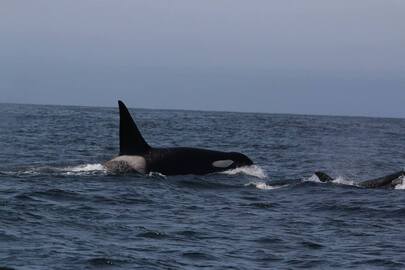I am collaborating with Dr. Kim Parsons (NOAA Northwest Fisheries Science Center) and Professor Ryan Kelly (University of Washington) to develop novel environmental DNA (eDNA) methods for elucidating population genetics of harbor porpoises and southern resident killer whales. The goal is to use eDNA population genomics to inform successful management of these economically and culturally important species. Current methods to investigate population genetic structure of marine mammals are either invasive, requiring tissue biopsies, or infrequent and haphazard, relying on opportunistic sampling of stranded individuals. However, eDNA approaches provide a non-invasive genomic sampling method relying on the collection and sequencing of sea water around the target marine species.
Southeastern Alaska Harbor Porpoises
Harbor porpoises play critical roles in nearshore marine ecosystems, but understanding the population genetic structure of these small agile marine mammals is challenging as tissue samples are only opportunistically available from strandings and bycatch. Thus we are developing eDNA tools to scale up our ability to map and understand population structure of harbor porpoises in Southeast Alaska. This information is critical to better understanding the connectivity of harbor porpoises within the coastal waters of Southeast Alaska to the larger harbor porpoise population in the Northeast Pacific to inform bycatch management efforts.
Southern Resident Killer Whales
Southern Resident Killer Whales are one of the most famous and well studied marine mammals and wildlife in the world. Years of intensive research has allowed scientists and whale-watchers alike to identify individuals from the three pods through photo identification. In addition, the vast majority of whales have been biopsied and genotyped, allowing us to know individuals within each pod. The ability to identify individuals in the wild make these iconic species an ideal test case to apply eDNA population genetics approaches. Thus we aim to demonstrate the ability of eDNA population genetics methods to monitor population structure and connectivity of southern resident killer whales to provide scientists and resource managers tools to monitor killer whales globally. This method has the potential to revolutionize how we survey and monitor marine mammals to better inform conservation and management efforts of these economically and culturally important species.
Cook Inlet Beluga Whales
Cook Inlet Beluga populations have declined substantially in the past three decades and significant management efforts impacting local communities have been put in place. In order to effectively manage and recover the population more information on the diet and predation patterns are needed. We are using a suite of targeted metabarcoding tools to try to understand Beluga feeding patterns in the Cook Inlet and Kenai River.


